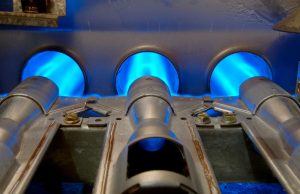 The standing pilot light was the conventional way that natural gas furnaces lit their burners whenever the heating system turned on. They’ve become so identified with home furnaces that people take for granted that pilot lights are still around doing the same job as usual.
The standing pilot light was the conventional way that natural gas furnaces lit their burners whenever the heating system turned on. They’ve become so identified with home furnaces that people take for granted that pilot lights are still around doing the same job as usual.
This isn’t the actual situation, however. Although you can still find gas furnaces with standing pilot lights, they have mostly gone of out use since 2010. If you have a furnace installed after that year, it almost certainly doesn’t use a pilot light to light the burners but an electronic ignition system.
The Problems With Standing Pilot Lights
What happened to cause the pilot light to decline in use? Although pilot lights have done reliable work at getting furnaces to start heating, they also came with several drawbacks that made it desirable to find a new type of igniting system. Pilot lights had two disadvantages:
- They wasted energy throughout the heating season. A standing pilot light must remain lit so the furnace can come on whenever it needs to, so the light continues to consume natural gas through the season even when the heater isn’t running. This lowered the energy efficiency of a furnace. It’s difficult to have an furnace with higher than 78% AFUE if it uses a standing pilot light.
- Standing pilot lights aren’t reliable and often go out. Almost any homeowner who used a gas furnace with a pilot light has a story about struggling to get an extinguished pilot light to stay lit just to get heat.
Around the 1970s, the first electronic ignition systems started to appear in furnaces. By the mid-1990s, electronic igniters began to rapidly surpass standing pilot light systems.
Electronic Ignition Systems
The development of several types of electronic igniters for gas furnaces helped tremendously with increases in the AFUE ratings for new furnace models. Electronic ignition was also more reliable than using a standing pilot light, and it’s easier for technicians to repair them when they fail.
Several types of electronic ignition systems have been developed. The two most common are hot surface igniters and intermittent pilot lights.
- Hot surface igniters. Sometimes called hot wire igniters, these systems work by raising the temperature of a filament with electric current, similar to the way a filament in a lightbulb grows hot. When the furnace receives a signal to start the heating cycle, gas starts to flow to the burners and the igniter glows hot until the burners ignite.
- Intermittent pilot lights. Also called electric spark igniters, these systems still use the flame of the pilot light to ignite the burners, but the pilot only remains burning long enough to do the job. An electric spark lights the pilot light assembly when the furnace turns on, and as soon as the flame sensor detects the burners are lit, the gas to the pilot light shuts off.
No matter what type of furnace you currently have, you can count on our technicians for excellent heater service in Essex, VT and the rest of our service area.
Red Rock Mechanical, LLC serves Northwest Vermont and Northeast New York. Schedule heating service with our team today—we have 24-hour emergency service available.







